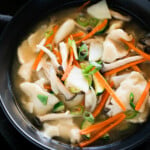If you’ve never had sujebi before, you should try it. It is a classic Korean noodle dish that is served in warm broth. It is a great comfort food. Learn how to make it and incorporate it in your own cooking today!

What is Sujebi
Sujebi (수제비) is a Korean style pasta-broth noodle soup that can be both warming and filling. The noodles are soft and chewy, the broth is rich with umami, and it is often served with as little as kimchi.
Sujebi uses only a few basic and inexpensive ingredients, which is why it became popular after the Korean War. That’s because some Koreans who were living in poverty at the time couldn’t afford rice. It was considered high-class food prior to that, as wheat was expensive and scarce.
The dish is also similar to kalguksu (knife cut noodle soup). The main difference between these is that sujebi soup use torn dough instead of cut noodles, so each dough is irregular in shape. For this reason, sujebi is also called “hand-torn noodle soup”, “hand pulled noodle soup” or “dough flake soup”.
There are many different varieties of sujebi – such as Gamja Sujebi (potato centric dough flake soup), Kimchi Sujebi (kimchi dough flake soup), Haemul Sujebi (seafood dough flake soup), and Deulggae Sujebi (perilla seeds flavor dough flake soup).
Sujebi is a favorite dish among Koreans during winter and for good reason. A hearty and simple meal, sujebi is perfect for rainy days and cold evenings.

Cooking Tips
As the key element of sujebi is soup and noodles, making these well will be very important to make delicious sujebi at home.
Korean Soup Stock
This Korean soup stock is the backbone of many delicious Korean soups and stews. It is typically made with dried anchovy and dried kelp, but you can also use just one or the other. You can make the flavor more complex by adding daikon radish, green onion, etc.
You can also buy a pre-packaged dashi or yuksu pack (pouch version) from a Korean grocer, which will make the cooking even faster and more convenient.
Homemade Korean soup stock can be made ahead of time and it is freezer-friendly.
Hand Pulled Noodles
The highlight of this noodle soup is definitely the hand-pulled noodles. Many people make them at home, although that can be a bit labor intensive. It can hurt your wrist and hands as you pull the dough a lot, especially if you are making a large volume of them.
To give the noodles a nice elastic texture, it is important to knead well (give it lots of massage!) and chill the dough in the fridge for 2 hours.
Also, try to flatten and make the dough as thin as possible, so that it doesn’t give you a doughy texture when you eat it. Thick doughy dough flakes are unpleasant to chew and don’t absorb the flavor as well as thin ones.
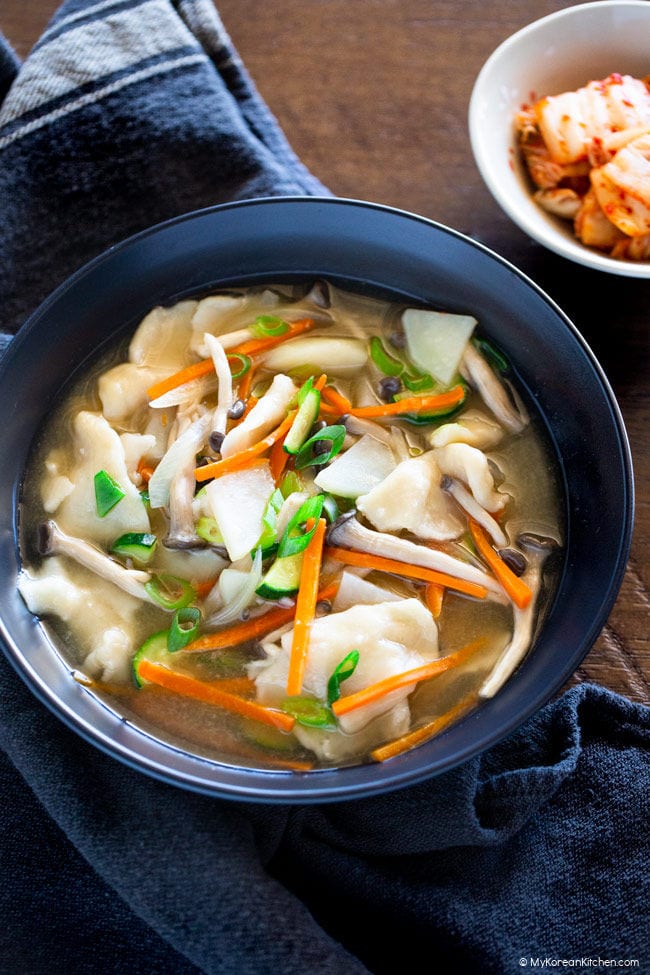
Easy Homemade Dough Alternative
If you don’t feel like putting in the extra labor required to make homemade pulled noodles or you’re short on time, you can buy pre-packaged, ready-to-use dough from a Korean grocer. It’s convenient, tastes just as good, and can be found in the fridge or freezer section.
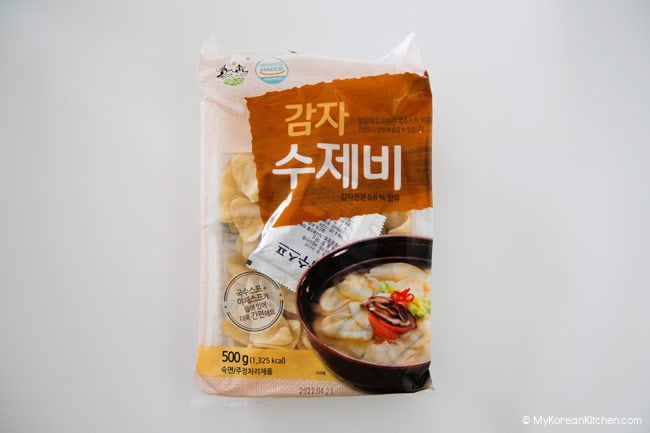
Other Korean Noodle Soup Recipes You Might Like
If you love noodle soup with Korean flavor, you should check these out. They all taste amazing in different ways.
- Jjampong (Spicy Seafood Noodle Soup)
- Janchi Guksu (Banquet Noodle)
- Kalguksu (Knife-Cut Noodle Soup)
- Mul Naengmyeon (Korean Cold Noodle Soup)
Ingredients for Sujebi

Hand Pulled Noodles
- 1.5 cup plain flour
- 1/2 Tbsp cornstarch or potato starch
- 1/4 tsp fine salt
- 1/2 cup water
Soup
- 4.5 cups Korean soup stock (dashi stock)
- 200g (7 ounces) potato, peeled and cut into thin bite sized pieces (about 0.5 to 1cm /0.2 to 0.4 inch thickness)
- 50g (1.8 ounces) onion, peeled and thinly sliced
- 75g (2.6 ounces) carrots, peeled and julienned
- 100g (3.5 ounces) zucchini, thinly sliced (about 0.5 to 1cm /0.2 to 0.4 inch thickness)
- 100g (3.5 ounces) oyster mushrooms or shiitake mushrooms, separated or thinly sliced
- 1 Tbsp Korean soup soy sauce (gukganjang) or kikkoman regular soy sauce
- 1/2 tsp fine salt
- 1 tsp minced garlic
Garnish
- 20g (0.7 ounces) green onion, thinly sliced
* 1 Tbsp = 15 ml, 1 cup = 250 ml
** If you want to learn more about Korean ingredients, check essential Korean ingredients list.
How To Make Sujebi
1. Prepare the medium bowl, then add the flour, cornstarch, and salt. Gradually add the water to it while mixing with a spatula in between. (i.e. Add one third of the water first and mix well with the flour. Add another third of the water and mix.) Do this until a rough dough forms.
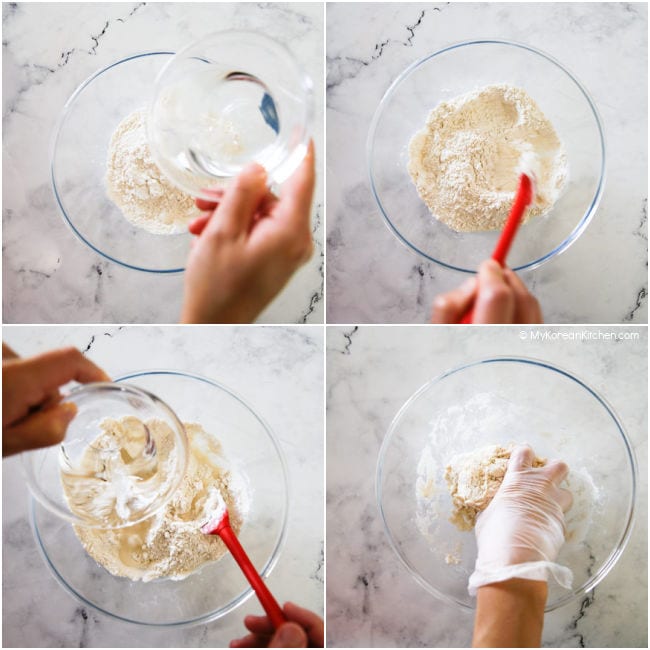
Be aware that you may need to adjust the amount of water you use depending on your room temperature. If it feels powdery, you need more water and if it starts sticking to your hands too much, you will need more flour. When you have to make an adjustment, do so in small increments.
2. Knead the dough for about 5 minutes or until it sticks together firmly, is smooth, and elastic. Put it in a plastic bag and seal well. Chill the dough in the fridge for 2 hours.
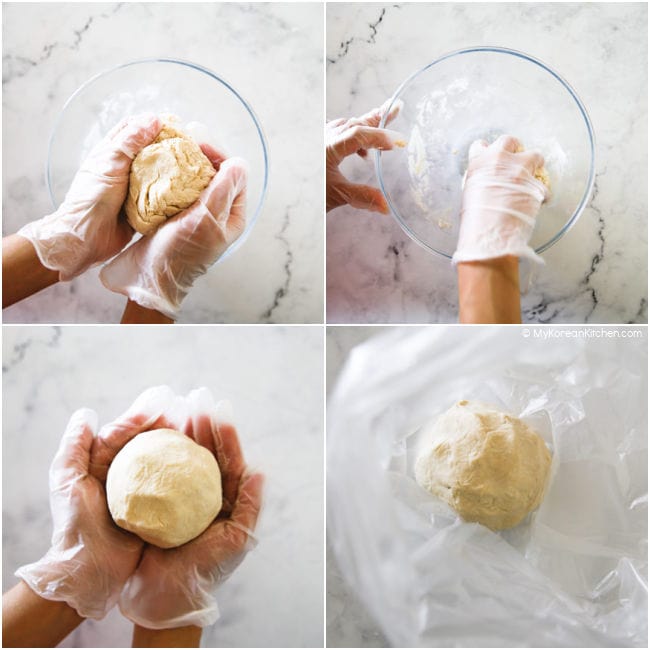
3. Prepare a medium-size pot and start boiling the soup stock over medium-high heat. Add the potato and onion. Boil for about 10 minutes.
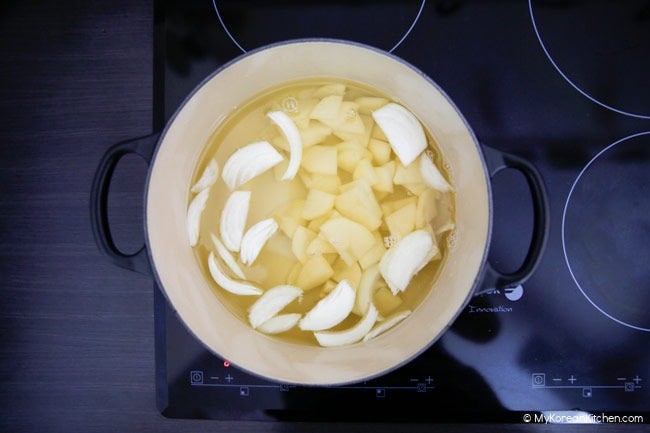
4. While the soup is boiling, place a small bowl of water next to the stove. This will be used for wetting your fingers (mostly thumb and index finger) to easily stretch and pull the dough. It also helps to make the dough flakes thin, which means not a doughy bite!
Take the dough out of the fridge. Hold the dough in one hand and use your thumb and index finger from your other hand to flatten it a bit. Pull it to stretch and thin the dough.
Tear the dough into flat, bite-size pieces (2.5 to 4 cm or 1 to 1.5 inch size), then drop it into the soup as you progress.
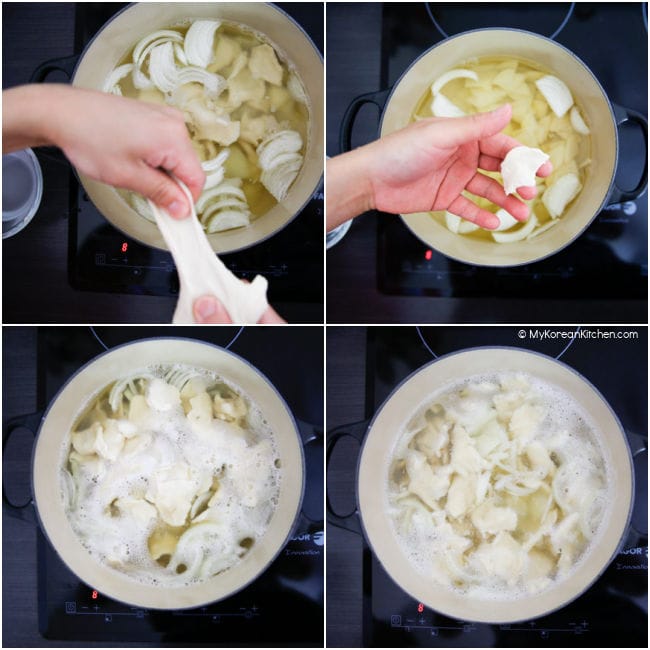
Repeat this until the dough is used up. This step can be quite time-consuming and requires lots of patience. It took me about 8 minutes to complete this step.
5. Reduce the heat to medium and add the soy sauce, salt, minced garlic, carrots, zucchini and mushroom. Stirring occasionally, cook for 5 minutes or until the vegetables are softened, but not too tender. Cooked dough pieces should look translucent and floating in the soup. Garnish with the green onions.
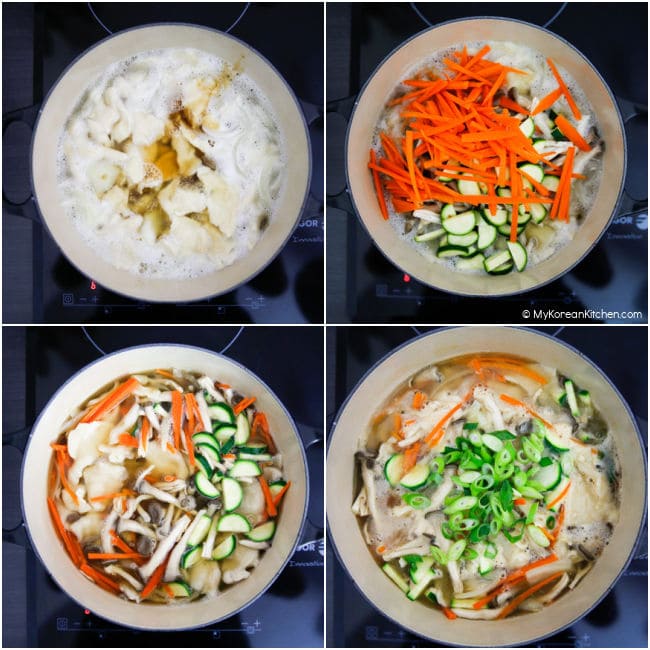
6. Serve with some kimchi.
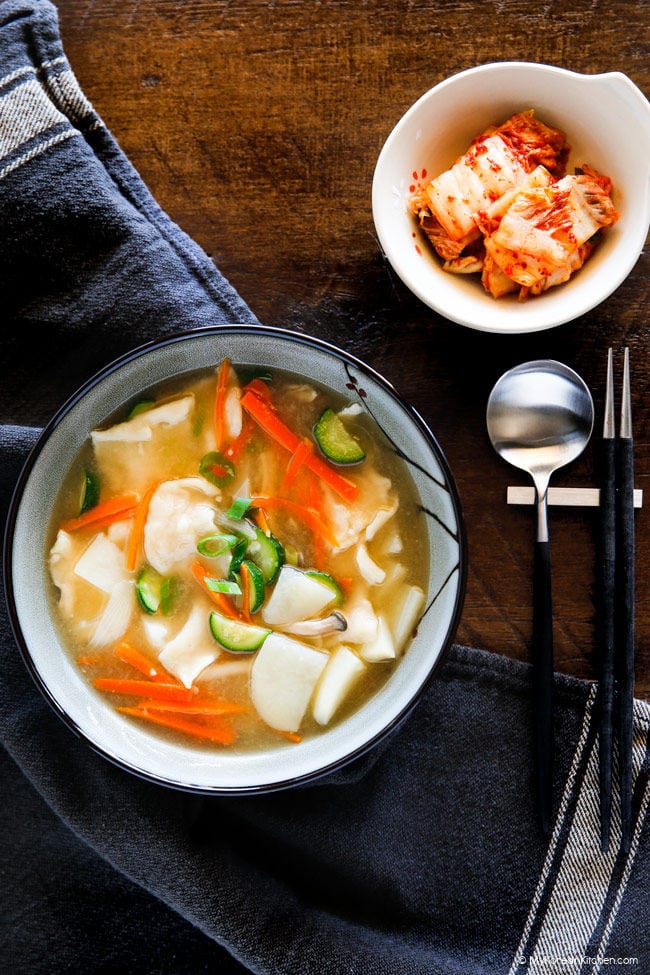
Love Korean food? Browse lots more Korean recipes from my easy Korean recipe collections. And subscribe to my newsletter and follow along on Facebook, Pinterest and Instagram for all of the latest updates.

Sujebi
Ingredients
HAND PULLED NOODLES
- 1.5 cups plain flour
- 1/2 Tbsp cornstarch or potato starch
- 1/4 tsp fine salt
- 1/2 cup water
SOUP
- 4.5 cups Korean soup stock (dashi stock)
- 200 g potato (7 ounces), peeled and cut into thin bite sized pieces (about 0.5 to 1cm /0.2 to 0.4 inch thickness)
- 50 g onion (1.8 ounces), peeled and thinly sliced
- 75 g carrots (2.6 ounces), peeled and julienned
- 100 g zucchini (3.5 ounces), thinly sliced (about 0.5 to 1cm /0.2 to 0.4 inch thickness)
- 100 g oyster mushrooms or shiitake mushrooms, (3.5 ounces), separated or thinly sliced
- 1 Tbsp Korean soup soy sauce (gukganjang) or kikkoman regular soy sauce
- 1/2 tsp fine salt
- 1 tsp minced garlic
GARNISH
- 20 g green onion (0.7 ounces), thinly sliced
Instructions
- Prepare the medium bowl, then add the flour, cornstarch, and salt. Gradually add water to it while mixing with a spatula in between. (i.e. Add one third of the water first and mix well with the flour. Add another third of the water and mix.) Do this until a rough dough forms.Be aware that you may need to adjust the amount of water you use depending on your room temperature. If it feels powdery, you need more water and if it starts sticking to your hands too much, you will need more flour. When you have to make an adjustment, do so in small increments.
- Knead the dough for about 5 minutes or until it sticks together firmly, is smooth, and elastic. Put it in a plastic bag and seal well. Chill the dough in the fridge for 2 hours.
- Prepare a medium-size pot and start boiling the soup stock over medium-high heat. Add the potato and onion. Boil for about 10 minutes.
- While the soup is boiling, place a small bowl of water next to the stove. This will be used for wetting your fingers (mostly thumb and index finger) to easily stretch and pull the dough. It also helps to make the dough flakes thin, which means not a doughy bite!Take the dough out of the fridge. Hold the dough in one hand and use your thumb and index finger from your other hand to flatten it a bit. Pull it to stretch and thin the dough.Tear the dough into flat, bite-size pieces (2.5 to 4 cm or 1 to 1.5 inch size), then drop it into the soup as you progress.Repeat this until the dough is used up. This step can be quite time-consuming and requires lots of patience. It took me about 8 minutes to complete this step.
- Reduce the heat to medium and add the soy sauce, salt, minced garlic, carrots, zucchini and mushroom. Stirring occasionally, cook for 5 minutes or until the vegetables are softened, but not too tender. Cooked dough pieces should look translucent and floating in the soup. Garnish with the green onions.
- Serve with some kimchi.
The nutrition information shown is an estimate provided by an online nutrition calculator. It should not be considered a substitute for a professional nutritionist’s advice.
